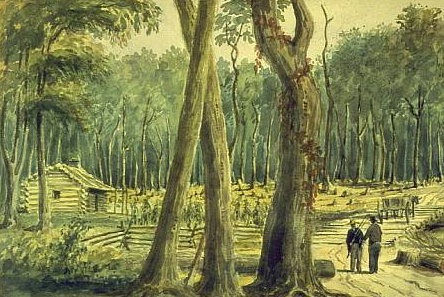FARMING:
pioneer homestead, Chatham, Upper Canada 1828 P.J. Bainbrigge
I chose this picture for farming because it shows the people involved and the actual landscape. First you see the farmer talking to a man with a top hat who most likely is the owner of the land. Behind them you can see the crops growing and the cleared area of forest he has created his farming lot in. A cow is waiting on the bridge who seems to be attached to some sort of carriage. The log hut is a good indication that he built his own house using the nearby trees.

SOCIALS CLASS:
King St. E., looking e. from Toronto St., Young, Thomas, Year/Format: 1835, Picture
Here you can see how the people are dressed in nice gowns and with the head boquotes and the men in all black suits. n the background you can see maybe parliament or court houses very polished and clean. There’s a paved way for the people. Closer to the front you see an Ox pulling grains and cloth with the farmer/ trades men nearby possibly there to sell and trade with other merchants.

RELIGION:
Court House and Jail, York, Upper Canada. 1829. NORTH SIDE OF KING, EAST OF TORONTO STREET, 1829 (JAMES PATTISON COCKBURN) This watercolour shows the jail and courthouse – both built in 1824 – and the first St James’ Church of 1807 after being enlarged between 1818 and 1821. Library and Archives Canada, C-149951
In the description to this picture it names the buildings. The first one we see is the court house then the jail and at the far end slightly tinted blue we see the church. Religion was obviously extremely important and held to a high standard. It was so important t was placed along file with the court house implying that both law and religion go hand in hand.

LAND ISSUES:
Crown and Clergy Reserves, Newtown, Upper Canada, with one-seventh of the land held for clergy reserves, and oneseventh to produce government revenue, c. 1800. National Archives of Canada, NMC288

This is a chart from the clergy showing the empty squares as the lots of land that they didn’t use or developed as for farming but kept in case they wanted to sell the land for a mora expensive price. The other land parts which were often not as good they rented to the villagers/farmers.
LOYALTY TO BRITAIN:
Encampment of the Royal Regiment at London, Canada West. Artist: Ainslie, Henry Francis, 1803-1879. June, 1842

I see cut down trees and British soldiers because there wearing red. People moving to Canada came from Europe therefore they were loyal to Britain as Britain still was their main leader.










